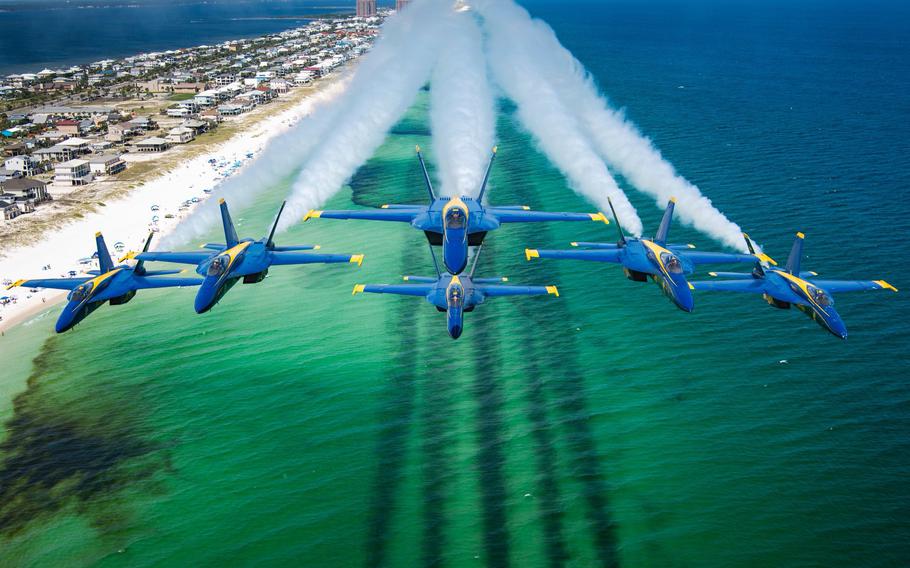
The U.S. Navy Blue Angels perform a demonstration during the Pensacola Beach Air Show in Florida, July 9-12, 2025. (U.S. Navy Blue Angels via Facebook)
TWIN FALLS, Idaho (Tribune News Service) — For 45 minutes, it’s draining, both physically and mentally.
But in the end, the job has its rewards.
It’s all a part of being a member of the Blue Angels team, which is in Twin Falls for shows Saturday and Sunday at Joslin Field, Magic Valley Regional Airport.
“It’s the hardest flying I’ve done,” flight leader Cmdr. Adam Bryan told the Times-News on Thursday.
But when it comes to benefits, “I have the honor of working alongside 160 of the finest sailors and Marines in the entire U.S. Navy and Marine Corps,” Bryan said.
Maintaining focus is key, he said, as he closes the canopy of his F/A-18 Super Hornet before showtime, and the trust shared between him and his five wingmen is immense.
They trust him to lead the team as they perform their 45-minute routine. And he counts on them — with g-force taking a toll on their bodies — to carry out maneuvers with exactness.
“If we have a bad maneuver, you forget about it,” he said. “If we have a great maneuver, we have to forget about it because the next one is coming up.”
Bryan has done plenty of flying before assuming the role of commander in November, being recognized as the George Bush First Tour Naval Aviator of the Year in 2011 and as the Commander Naval Air Force Atlantic Pilot of the Year in 2016.
He’s logged more than 3,200 flight hours on five aircraft.
About 20 minutes into the show, the Blue Angels perform a maneuver in which the jets fly in a diamond formation, he said.
“It looks very benign from the crowd’s perspective,” he said. But in reality, the maneuver is tricky because the aircraft are so close to one another. Each aircraft can affect the others due to their proximity, literally “pushing” them.
But the hardest maneuver, Bryan said, is the “fleur-de-lis,” a signature breakout maneuver that comes at high speeds and doesn’t allow for error.
He stays in close contact with the other pilots as they go into their maneuvers.
“We have to be safe and look as good as possible,” Bryan said. Focus is intense among the pilots during their time in the air.
But once the F-18s return to the ground, the pilots can hear the crowd’s roar of appreciation for a job well done, Bryan said.
The Blue Angels start laying the groundwork one or two years before a show and count on air show volunteers as a vital component.
One hundred sixty members of the Blue Angels team make the show appear seamless.
Lt. Ben Bushong, public affairs officer, flew helicopters for the Navy for five years before injuries caused him to pivot his career. He joined the Blue Angels team in September 2023.
“When I look back on my Naval career, it will be one of the highlights,” Bushong said.
Being on the team involves a lot of travel, with some members being on the road from 200 to 300 days each year, but he sees work with the Blue Angels as a way to potentially inspire the next generation to pursue greatness.
Being a member of the team has its perks; team members are promised at least one flight in the backseat of an F-18. Gabe Whisman, an enlisted officer in charge of aircraft maintenance, looks forward to it — maybe next year.
“The bubble canopy offers phenomenal views,” Navy Lt. Cmdr. Lilly Montana said.
As events coordinator, Montana visited in January to meet with air show organizers and discuss logistics. She also has pilot training and has accumulated 1,000 flight hours.
© 2025 The Times-News (Twin Falls, Idaho).
Visit magicvalley.com.
Distributed by Tribune Content Agency, LLC.